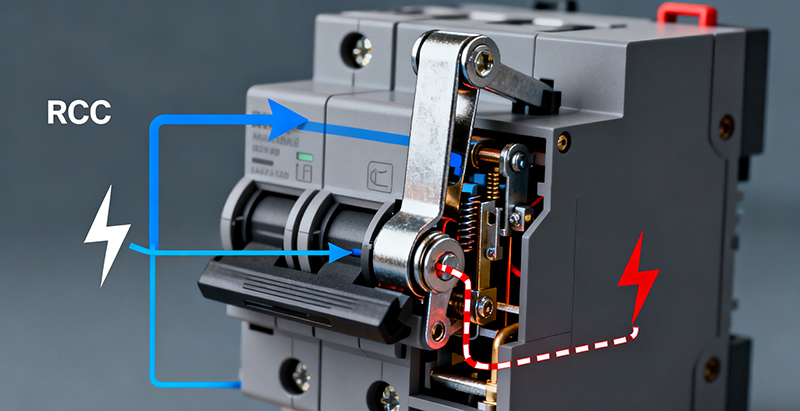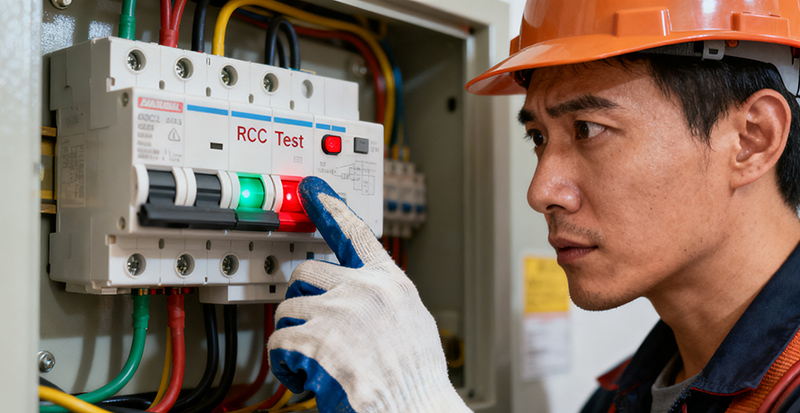Get quick appointment for technical support!
The Ultimate Guide to Residual Current Circuit Breakers (RCCBs)
Sep 19,2025

When it comes to electrical safety, Residual Current Circuit Breakers (RCCBs) are essential devices for protecting users from electric shocks. Often called RCDs or RCD circuit breakers, these devices cut off the electrical supply when they detect leakage currents.
This helps prevent accidents caused by faulty electrical systems. In this guide, we’ll explore residual current circuit breakers, covering how they function, why they’re necessary, and how to troubleshoot common issues.
What is a Residual Current Circuit Breaker?
A Residual Current Circuit Breaker (RCCB), also known as an RCD device, is a safety device that disconnects the electrical supply when it detects an imbalance between the live and neutral wires. The residual current detector measures the current flowing through the circuit.
If there’s a difference between the live and neutral currents, it indicates a leakage, which could be due to faulty appliances, damaged wiring, or someone touching a live wire.
When the imbalance exceeds a certain threshold, the RCCB trips and cuts off the power, preventing electric shocks and reducing the risk of electrical fires.
Why is it Important?
RCCBs are vital for electrical safety and play a key role in protecting lives and property.
Protection Against Electric Shocks
The primary function of an RCD circuit breaker is to prevent electrocution. If a person comes into contact with a live part, the RCCB immediately disconnects the electricity, reducing the risk of serious injury or death.
Preventing Fires
RCCBs prevent electrical fires by detecting leakage currents that could lead to overheating or short circuits. By tripping the circuit when a fault occurs, the RCD switch prevents potential fire hazards.
Equipment Protection and Compliance
In addition to safety, residual current devices (RCDs) protect electrical equipment from damage caused by faults. They also help meet safety regulations in areas where electrical risks are higher, such as kitchens and bathrooms.
How does a residual current circuit breaker work?
The operation of an RCD circuit breaker is based on the principle of detecting an imbalance between the live and neutral current. Here’s how it works:
Normal Condition
In an electrical circuit, the current flowing through the live wire should equal the current returning via the neutral wire. Under these conditions, no imbalance is detected.
Leakage Detection
If a leakage occurs—whether due to a faulty appliance, damaged wires, or a person coming into contact with a live part—some current will escape, either through the ground or another path. The RCCB detects this leakage or imbalance between the live and neutral currents.
Triggering the RCCB
When the difference between the live and neutral currents exceeds a preset threshold (usually 30mA for personal protection), the residual current device quickly trips, cutting off the power supply. This action happens in a fraction of a second to ensure maximum safety.
Restoring the Circuit
Once the fault is identified and corrected, the RCCB can be manually reset, restoring power to the circuit.
This makes residual current devices highly effective in preventing electric shocks and reducing the risk of fire due to electrical faults.
Advantages and Disadvantages of Residual Current Circuit Breakers
Advantages
Enhanced Safety
The primary advantage of RCD circuit breakers is the protection they offer against electric shocks. In the event of a fault, the RCD device disconnects the supply of electricity instantly, minimizing the risk of injury or death.
Fire Prevention
Residual current devices are excellent at preventing electrical fires. If a faulty appliance or circuit leaks current, it could potentially start a fire. An RCD residual current device will cut off the power supply before a fire can occur.
Simple Installation
RCD switches are relatively easy to install and can be retrofitted into most electrical systems. This makes them a popular choice for upgrading existing electrical systems to meet modern safety standards.
Compliance with Electrical Regulations
In many countries, residual current circuit breakers are required by law in new constructions and renovations. Installing these devices ensures compliance with local electrical codes and safety standards.
Versatility
RCCBs are versatile and can be used in a wide range of applications, from residential homes to industrial facilities. They can be installed as individual devices or as part of an RC circuit breaker system to provide broader protection.
Disadvantages
False Tripping
One of the main disadvantages of RCD devices is that they can sometimes trip unnecessarily. This can happen due to minor imbalances in the electrical circuit, such as high inrush currents when appliances like refrigerators or air conditioners start.
Limited Protection
RCD switches are designed to detect leakage currents, but they do not provide protection against other electrical issues, such as overloads or short circuits.
For comprehensive protection, RCCBs should be used in conjunction with other circuit protection devices, such as fuses or traditional circuit breakers.
Cost
While generally affordable, the installation of residual current circuit breakers can add to the upfront costs of an electrical system. However, considering the added safety, this investment is often well worth it.
Types of Residual Current Circuit Breakers
There are several types of RCD circuit breakers designed for different applications. These are the most common:
1. Standard RCCBs
These devices are designed to provide protection against leakage currents in standard residential and commercial circuits. They are the most basic form of residual current devices (RCDs).
2. Type A RCCBs
Type A RCCBs offer protection against both alternating (AC) and pulsating direct (DC) currents. These are suitable for modern homes with electronic devices that may generate such faults.
3. Type B RCCBs
Type B RCCBs provide the highest level of protection, detecting all types of leakage currents, including AC, pulsating DC, and smooth DC. These are often used in specialized applications, such as electric vehicle (EV) charging stations.
4. RCBOs (Residual Current Breaker with Overload Protection)
An RCBO is a combination of an RCD residual current device and an overload protection device. It provides protection against both leakage currents and overloads in a single unit. These are often used in areas where space is limited.
Installation and Maintenance of RCCBs
Installation
Installing a residual current circuit breaker requires a few key steps:
Choose the Right Type
Select the correct RCD device type based on the level of protection needed (standard, Type A, Type B, or RCBO).
Correct Placement
RCCBs should be installed in the distribution board (also called the electrical panel), positioned before other circuit breakers to provide maximum protection.
Proper Wiring
Make sure the live and neutral wires are connected correctly to the RCCB. Miswiring can cause the device to malfunction or fail to trip when necessary.
Consult a Professional
Always consult a qualified electrician for installation. A licensed professional ensures compliance with local electrical codes and proper installation.
Maintenance
Routine Testing
Test the residual current circuit breaker regularly using the built-in test button. This helps ensure the device is functioning properly. It’s recommended to test it every 3 months.
Visual Inspection
Periodically inspect the RCCB for signs of wear, such as damage to the device or signs of overheating.
Replacement
If the RCD switch fails to trip during testing or shows signs of damage, it should be replaced immediately by a qualified professional.
Troubleshooting Common Issues with RCCBs
Even the best residual current devices can face issues. Here are some common problems and solutions:
1. RCCB Keeps Tripping
Possible Cause: A faulty appliance or moisture in the wiring could be causing leakage.
Solution: Disconnect all appliances and check if the RCCB trips. If the device doesn’t trip, the issue might lie within the circuit.
2. RCCB Won’t Trip
Possible Cause: A malfunctioning residual current detector or incorrectly wired RCCB.
Solution: Test the RCCB using its test button. If it doesn’t trip, it may need to be replaced.
3. RCCB Trips Without Apparent Reason
Possible Cause: Some devices, such as refrigerators or air conditioners, cause high inrush currents that may trip the RCCB.
Solution: Ensure the RCD plug or device is of the correct type (Type A or Type B) and that it can handle inrush currents.
Conclusion
Residual current circuit breakers (RCCBs) are key components in any electrical system, providing protection against electric shocks, fire risks, and damage from leakage currents.
Whether for home use or in commercial and industrial settings, understanding how RCD devices work, their benefits and drawbacks, and how to maintain them is essential for electrical safety.
By choosing the right RCD switch and keeping it properly maintained, you ensure your electrical systems remain safe, meet safety regulations, and are free from potential hazards.
--- END ---
